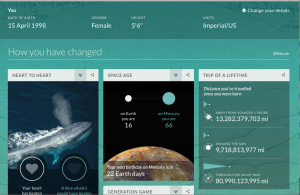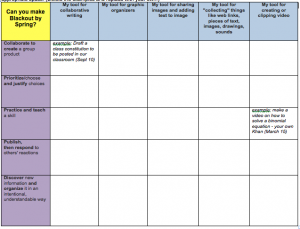A Gift to You: My All-time Favs
 As I approach the end of the year and the end of my time as lead “Thinking Teacher,” I am using my gift-giving powers to share my all time favorite TeachersFirst resources as the “Featured Sites” for December 21/28 and January 4 (my last week to select the Features). I don’t want to ruin all the surprises, but will open a few presents a little early. You will have to watch the Featured Sites or TeachersFirst Update for the rest. (New Featured Sites appear every Sunday, except when we leave them online for two weeks during the holidays.)
As I approach the end of the year and the end of my time as lead “Thinking Teacher,” I am using my gift-giving powers to share my all time favorite TeachersFirst resources as the “Featured Sites” for December 21/28 and January 4 (my last week to select the Features). I don’t want to ruin all the surprises, but will open a few presents a little early. You will have to watch the Featured Sites or TeachersFirst Update for the rest. (New Featured Sites appear every Sunday, except when we leave them online for two weeks during the holidays.)
I had no stated criteria when I selected The List, just holistic, “gut” reactions. With over 16,000 resources from which to choose, I knew some that were destined for The List before I even started. Only after The List was complete did I stop to analyze why I choose certain resources as all time favs. Three reasons:
- Some resources inhale me through imagery, color, and a powerfully visual interface. I am a very visual person and love a visual experience of learning, wondering, and creating.
- A resource that allows me (and all users) to be creative, not just witness someone else’s creative musings. If it is both, even better: a creative product that entices me to try my own.
- Intellectual intrigue. If it makes me ponder something I never thought about — and I can imagine using it to pass along a feeling of intellectual intrigue to my students — it is a candidate for The List.
There are other, less important criteria, but the really good ones have all of the above. Secondary factors include open-endedness, tools or resources that are not “schooly,” places where the process of writing is a celebration and not a chore, places where history becomes real, tools so versatile they will never wear out, etc.
Bookemon made The List before I started. They may be selling printed books, but you never have to buy one. Anyone can make and share an online, interactive book. They added the EdCenter for teachers early on in their development, and they seem to be economically stable. Teachers need tools worth investing time in products without fear of “losing them.” I have made many books using Bookemon for both personal and professional use, and it is my go-to choice.
Inklewriter is a lesser known tool, but it has such potential for writing and creativity. I forgive them for not being more visual. Inklewriter is a challenge to any digital writer: planning for branches and the logic of how readers will experience what you write. I would have loved using this with gifted kiddos. Yes, you could create branched writing using other tools, but the inherent structure of Inklewriter tool helps you build a branching piece of writing and be sure you do not leave any “loose ends.” (Note I do not say it makes a branching “story” because it could make ANY type of branched writing.)
Lino is my go-to sticky note tool. Yes, many people know Padlet (once Wallwisher), but Lino had an app version earlier on, something I needed when I first bought an iPad. Visual, collecting, color coding… enough said. I have been using it to prep new web content, brainstorm, plan for ISTE presentations, etc. for a long time.
Murally is Lino on steroids. I haven’t used it personally, but I’d like to. Collect and collaborate live with all types of media. What a great way to grab stuff, sort it, and decide what to do with it, all as a group. Now if these tools would just automatically add a field for CREDITS attached to the things we grab from all around the web, we’d be modelling good digital citizenship, too.
Others on The List for Dec 21/28 include more writing/word tools and three amazing map-related resources. I will not tell you about January 4. I can’t spoil all the surprises that will be online soon.
It’s been a great run. I will miss crafting weekly posts for you. Pay it forward.
As you start your New Year with the TeachersFirst Featured Sites, I hope you will resolve to model creativity, consider a visual approach, and inspire intellectual intrigue. Thinking Teachers… Teaching Thinkers.







 This is a fable — of sorts.
This is a fable — of sorts.




